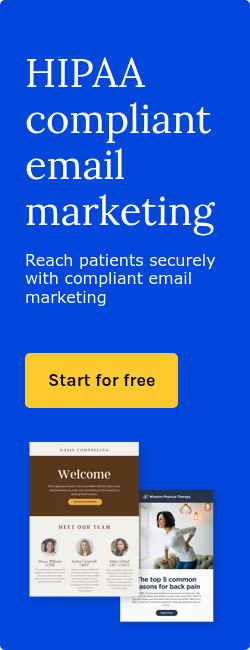
For healthcare organizations of all sizes, navigating the complexities of HIPAA regulations while engaging in email marketing can be concerning. This article will help healthcare organizations master opt-in email marketing while staying HIPAA compliant, ensuring that patient privacy is protected and marketing strategies are effective.
Key points:
- Importance of consent: Obtaining explicit, informed consent is the cornerstone of opt-in marketing. Healthcare organizations must provide clear and specific consent mechanisms.
- HIPAA compliance: Adhere to the HIPAA Privacy Rule and Security Rule when collecting, storing, and transmitting opt-in data.
- Opt-in vs. opt-out: Opt-in marketing requires active consent, reducing the risk of HIPAA violations and fostering trust with patients.
The details:
Consent
- Obtain explicit, informed consent before sending marketing communications. This should involve a clear and easy-to-understand consent mechanism, such as a checkbox, requiring users to actively indicate their consent to receive marketing materials.
- Ensure that your consent form provides information about the types of content and the frequency of emails that individuals can expect to receive.
HIPAA compliance
- Develop and implement policies and procedures for handling PHI during the collection, storage, and transmission of opt-in data. This may include encrypting email addresses, ensuring secure data storage, and using HIPAA-compliant email service providers.
- Provide ongoing training and education for your staff on HIPAA compliance and opt-in marketing best practices. This will help ensure that all employees know their responsibilities and can contribute to the organization's compliance efforts.
Opt-in vs. opt-out
- Opt-in marketing requires the individual to actively express their consent, unlike opt-out marketing, which assumes consent unless the individual explicitly withdraws it. This approach can help to reduce the risk of potential HIPAA violations and foster trust and transparency between the organization and its patients.
Related: HIPAA Compliant Email: The Definitive Guide
Exceptions & requirements:
Exceptions
Some communications, such as treatment options, appointment reminders, and healthcare-related services, are exempt from the opt-in requirement:
- Communications related to treatment
- Appointment reminders
- Healthcare operations
- Patient education
- Fundraising
- Prescription refill reminders
- Case management or care coordination communications
- Health-related products or services provided by the healthcare organization
- Health-related products or services recommended by the healthcare provider
Requirements
Provide a clear and conspicuous notice about the nature of the marketing communications and how the individual's information will be used. This includes explaining the type of content they will receive, the frequency of communications, and the option to withdraw consent at any time.
Maintain detailed records of individuals' opt-in consent, including the date, time, and method by which permission was obtained. This will help demonstrate compliance with HIPAA requirements and may be necessary in an audit or investigation.
Opt-in best practices:
- Implement transparent and specific consent mechanisms: Create easy-to-understand consent forms and provide information about the types of content and frequency of emails.
- Ensure HIPAA compliance in all aspects of opt-in marketing: Develop policies and procedures for handling PHI and provide ongoing staff training.
- Provide clear and conspicuous notice about marketing communications: Explain the type of content, frequency, and the option to withdraw consent at any time.
- Maintain detailed records of consent: Keep records of the date, time, and method by which permission was obtained to demonstrate compliance.
- Offer an easy-to-use unsubscribe mechanism: Include an easily accessible unsubscribe link in all marketing communications and promptly honor any requests to be removed from mailing lists.
- Verify third-party service providers' HIPAA compliance: Ensure that any third-party email service providers are also compliant with HIPAA regulations, which may involve signing a Business Associate Agreement (BAA) to ensure the protection of PHI.
- Provide ongoing training and education for staff: Offer regular training on HIPAA compliance and opt-in marketing best practices to keep employees informed.
Subscribe to Paubox Weekly
Every Friday we'll bring you the most important news from Paubox. Our aim is to make you smarter, faster.

 Dean Levitt
Dean Levitt



